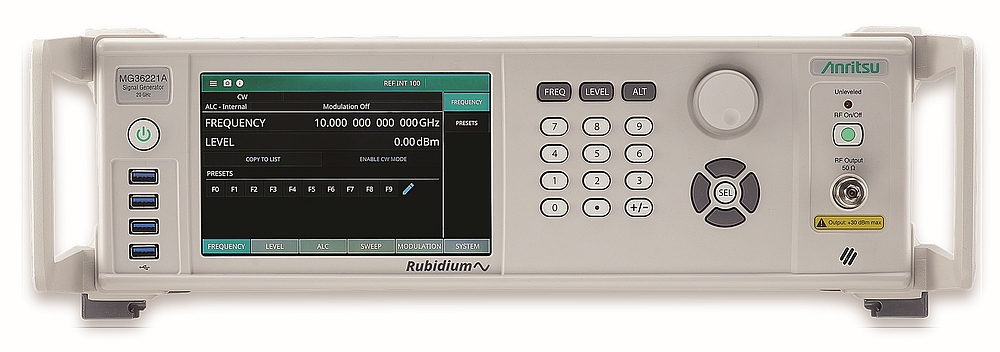- Anritsu announces the Rubidium family of signal generators covering a frequency range from 9 kHz to 20 GHz or 43.5 GHz.
- According to the Japanese manufacturer, these generators are suitable for applications requiring spectral purity and frequency stability.
- These instruments include a frequency and power calibration function that can be implemented on site.
Signal purity is essential for a wide range of measurement applications, from radar testing to A/D or D/A converter testing. The Rubidium signal generator has a single-sideband (SSB) phase noise of -136 dBc/Hz (typical) and -140 dBc/Hz (measured) at 10 GHz and 10 kHz of carrier. It offers output power ranging from -130 dBm to +20 dBm (20 GHz) or +18 dBm (43.5 GHz).
According to Anristu, the Rubidium offers an order of magnitude with better frequency stability compared to other signal generators that use an OCXO based reference. This frequency stability is achieved either by an optional internal Rubidium reference or by locking the signal generator’s time base to a 1 PPS reference from an optional internal GNSS/GPS atomic clock receiver.
The Rubidium signal generator features built-in, on-site frequency, and level calibration that is easily accessible with the touch of a button on the GUI interface. This feature ensures customer level, accurate frequency desired and increasing instrument availability. An Anritsu CW USB power sensor is required for onsite level calibration. An internal GNSS/GPS atomic clock receiver or ultra-stability rubidium time base option is required for onsite frequency calibration.
The Rubidium’s AM, FM/PM, and pulse modulation capabilities enables a wide range of complex analog modulated signals.
An internal low frequency generator can generate seven different waveform types to modulate the carrier. Additionally, simultaneous modulation of AM/FM, AM/PM, or FM/Pulse is possible to generate complex modulation waveforms such as chirps. Broad signal simulation capabilities are built into the signal generator for pulsed radar testing.
The Rubidium is housed in a 3U chassis with a 7-inch touch screen on the front panel with a traditional keypad/dial interface.
The Rubidium signal generator can be used in a variety of applications. It is ideal for applications which require low phase noise such as testing radar subsystems, up/down converters, or high-speed ADCs/DACs. The signal generator is well suited for conducting nonlinear measurements without additional filters. They can be used for a variety of interference measurements, as a signal source to test devices and systems, and as a frequency reference in calibration and metrology labs.






